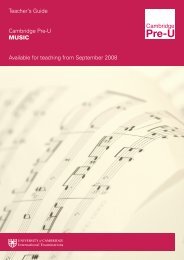Cambridge Pre-U Syllabus - Cambridge International Examinations
Cambridge Pre-U Syllabus - Cambridge International Examinations
Cambridge Pre-U Syllabus - Cambridge International Examinations
You also want an ePaper? Increase the reach of your titles
YUMPU automatically turns print PDFs into web optimized ePapers that Google loves.
14<br />
<strong>Cambridge</strong> <strong>Pre</strong>-U Draft<br />
In the context of the Curriculum Content Learning Outcomes of this syllabus, the following terms will be met<br />
and are intended to have meanings as shown in the table below.<br />
Term Intended meaning<br />
Limited to … The list of examples or level of detail given in the syllabus is considered to be<br />
sufficient at this level, so that inclusion of further examples or more detail is<br />
unlikely to be of benefit to candidates.<br />
Including …<br />
and<br />
e.g. …<br />
… with emphasis<br />
on …<br />
command words<br />
such as state,<br />
outline, describe,<br />
explain, suggests,<br />
compare and<br />
discuss …<br />
Question setters will assume that all candidates have studied the topic to the<br />
specified level of detail and included the specified examples.<br />
For some individual candidates and cohorts, sufficient examples or details are<br />
given to form a coherent understanding without any further exemplification or<br />
detail. For other individual candidates or cohorts, there may usefully be the<br />
opportunity to pursue the topic to a greater depth. Great care should be taken not<br />
to overload the course with content beyond the level that is intended, so that not<br />
every opportunity to include more material should be taken.<br />
Question setters will assume that all candidates have studied the topic to the<br />
specified level of detail and included the specified examples.<br />
This is an indication that the particular aspects of the topic so described should be<br />
the focus of most of the teaching and learning effort, and other aspects should<br />
form a smaller part, for example in cell division, where the features of chromosome<br />
behaviour that contribute to various outcomes should be studied in more detail<br />
than other aspects such as the changes to centrioles and nuclear membrane.<br />
A glossary is given at the end of the syllabus that lays out the intended meanings<br />
of these terms in the context of the assessment. This glossary will also be of<br />
considerable use in helping teachers and candidates determine the intended depth<br />
of study of the course.<br />
Use… The term use, in the syllabus learning outcomes, points out particular places where<br />
candidates will need to apply their understanding of aspects of Biology to the<br />
solving of problems, for example in genetics.<br />
Details of … are not<br />
required<br />
This is an area where it is considered that inclusion of the material specifically<br />
excluded from the syllabus is unlikely to be of benefit to candidates and might<br />
prejudice their progress in other areas that are essential to study at this level.<br />
Question setters will assume that no candidates have studied the material<br />
specifically excluded.

















